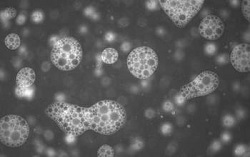 |
| Liposomes with microbubbles that implode with ultrasound can deliver drugs transdermally.--Courtesy of Drexel |
Although transdermal patches are often used to deliver smaller molecules through the skin, large compounds can be difficult to push through. To transport larger molecules such as insulin or arthritis medication through the skin via a patch, researchers at Drexel University have developed an ultrasound technique for delivering drugs and breaking down their containers at the desired target.
The team looked to avoid the side effects of the arthritis drug methotrexate, which can be toxic to the liver when taken orally, according to the National Science Foundation, which helped fund the research. To prevent the compound from even reaching the liver, the researchers needed to facilitate the passage of methotrexate, a molecule too large for normal transport through the skin, using both an engineered drug vehicle and an ultrasound technique for targeted release.
They used liposomes to protect the drug on its way through the skin, which can be a physically harrowing time for delicate molecules--they are rendered useless if they attempt the passage without a protective barrier. With a tunable ultrasound device included in the patch, the liposomes are pushed forward past the skin using tiny microbubbles.
But give these microbubbles enough ultrasound intensity and they implode, bursting the liposome and releasing the contents. In this way they can deliver the payload to the desired part of the body without causing harmful side effects elsewhere, all through a patch on the skin.
- here's the National Science Foundation report